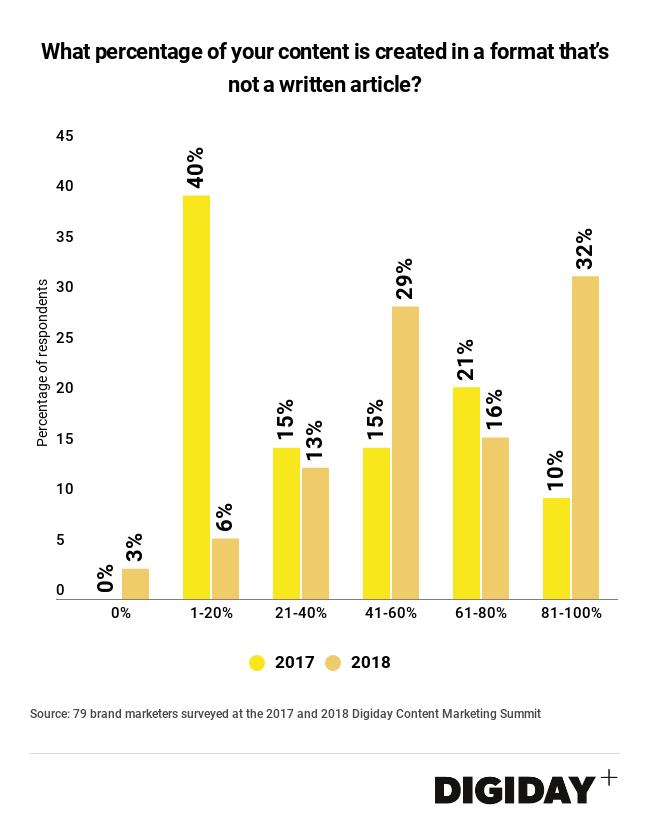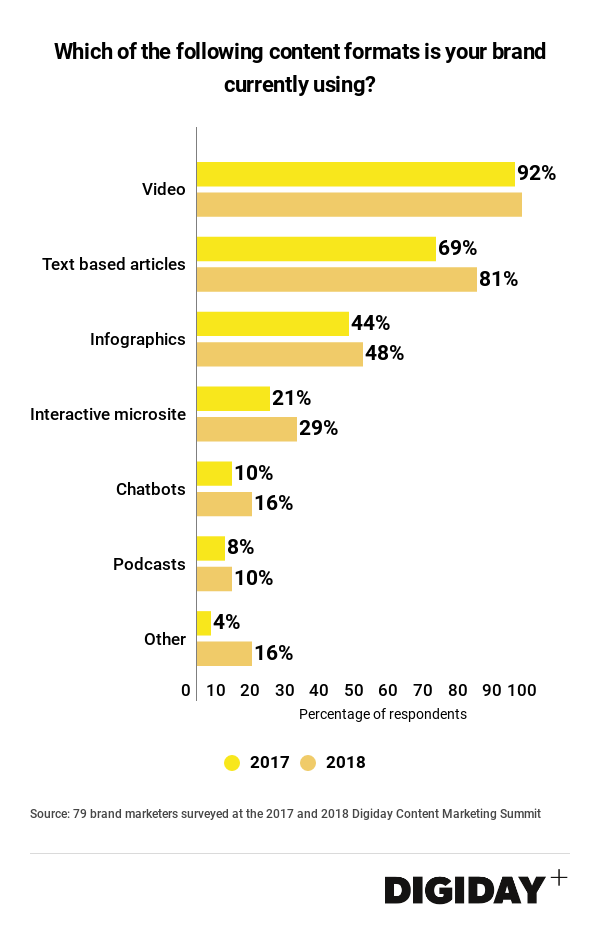Digiday Research: Marketers diversify content marketing formats

This research is based on unique data collected from our proprietary audience of publisher, agency, brand and tech insiders. It’s available to Digiday+ members. More from the series →
When it comes to formats for branded or sponsored content, written articles are falling out of favor with marketers fast. Increasingly they’re using other formats such as video, interactive sites, and infographics instead.
Just one year ago, over half of marketers said the majority of their content marketing was produced in the form of a written article. Fast-forward to 2018 and the number of marketers who say they still rely on text has more than halved to 22 percent, according to a survey of marketers at the Digiday Content Marketing Summit in August.
The continued rise of video is one likely explanation for the shift away from written content. As people consume more video and publishers and platforms do more to place video in front of them, marketers are, understandably, following suit. Video has distribution advantages too, and can be repurposed relatively easily for various platforms.

Among respondents to Digiday’s survey, video is now the most widely used form of content marketing, employed by 94 percent of marketers. Comparatively, written articles were used by 81 percent of marketers, an 12 percentage point increase over the previous year. This means that while written articles are being used by more marketers, they are also being used more sparingly.
Ad position: web_incontent_pos1
All other formats also saw an increase in use which suggest marketers are moving to a more diversified content marketing strategy, or are at least trying multiple formats until they figure out what performs best. Additionally nearly every respondent who checked the other box commented that they were using quizzes and polls as a format for content marketing.
Part of the reason for written articles’ persistence is their low cost compared to video. As one attendee to the summit told Digiday, “Video is hard because quality counts.” Producing quality video is not only expensive, so is purchasing premium video inventory for distribution.
But one potential risk with written content marketing is that it can mislead audiences. Nearly two-thirds of consumers in a study failed to notice articles that were labeled as sponsored and another study the found that if users feel tricked into reading content, unaware that it’s sponsored, those readers can often times develop negative associations with the companies and publishers behind the content.
Ad position: web_incontent_pos2

More in Marketing

In the marketing world, anime is following in the footsteps of gaming
As marketers look to take advantage of anime’s entry into the zeitgeist, they might be wise to observe the parallels between the evolution of anime as a marketing channel and the ways brands have learned to better leverage gaming in recent years.

With the introduction of video ads and e-commerce, Roblox looks to attain platform status
Roblox is expanding into more areas than just ads in 2024. Much like platforms such as Amazon and Facebook have transcended their origins to evolve from their origins as online marketplaces and social media channels, Roblox is in the midst of a transformation into a platform for all elements of users’ virtual lives.

PepsiCo wants to remain a ‘driver of culture’ as it turns to influencers and activations amid rebrand
The soda-maker says it can translate cultural relevance into sales volume.
Ad position: web_bfu